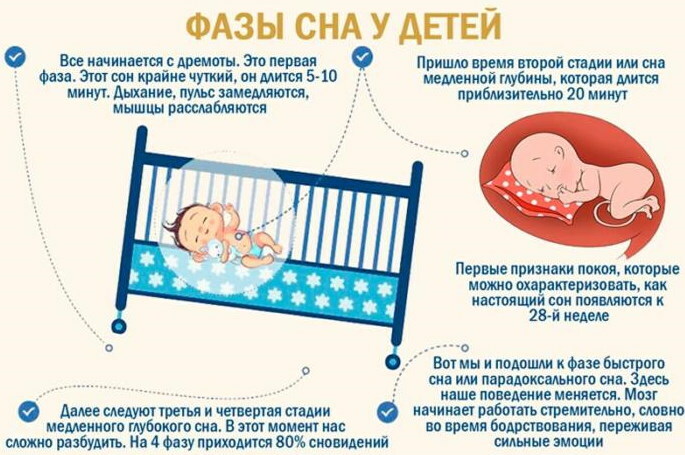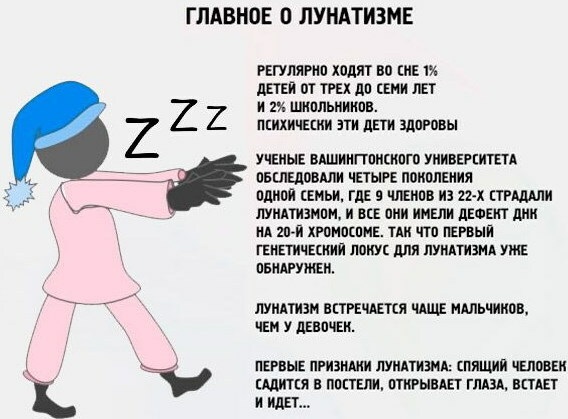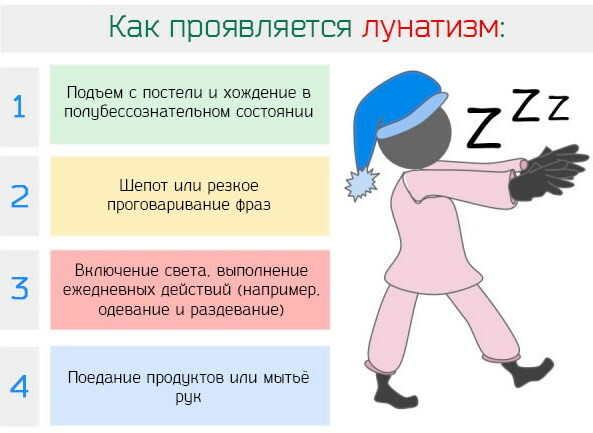Content
- What is sleepwalking
- Causes of sleepwalking in children
- Risk factors
- At what age can sleepwalking develop
- What is the danger of pathology
- Manifestations and symptoms
- What to do if a child has somnambulism
- Diagnostics
- Methods and treatment regimens
- Recommendations for parents
- Ensure the safety of the child
- Relieve tension, calm the child
- Establish a family environment
- Video about sleepwalking
Sleepwalking - sleep disorder that people find scaryespecially when it manifests itself in children. Catching a child in the middle of the night wandering around the room with wide eyes and at the same time completely emotionless is a sight that can cause anxiety among parents. Sleepwalking affects up to 3% of the world's population, including adults and children. The causes of the disorder, symptoms and methods of treatment will be discussed in the article.
What is sleepwalking
Somnambulism (the medical name for sleepwalking) is a parasomal disorder in which people, while in a state of sleep, perform certain actions. They can rise in bed, sit down, get up, walk around the room, talk, laugh, scream. Aggressive behavior is less common. The disease usually manifests itself in childhood, at the age of 3-4 years and more often manifests itself in boys.
With this deviation during sleep, a person unconsciously performs certain actions, while from the outside it may seem that he fully understands what he is doing, but this is not so. Sleepwalking occurs at the stage of slow sleep, after 1-1.5 hours after falling asleep. While performing actions in this state, a person does not respond to speech addressed to him and does not notice anything around him.
Sleepwalking is mostly found in children, which is associated with the immaturity of their nervous system. Until a certain age, the child's psyche cannot always adequately perceive the events that are taking place and therefore they continue to excite the child even in a dream. An impression can be made as something negative, for example, a scary cartoon, a game, an unpleasant situation or meeting, or positive - a holiday, a trip.
In the absence of abnormalities during sleep, the activity of all parts of the brain is inhibited. In this state, the muscles relax, the body spends a minimum amount of energy, rests and recovers. With sleepwalking, some of the centers of the brain, which are responsible for the awareness and perception of the real the world turns off, and the other part that regulates physical activity continues to send signals body.
As a result, the body reacts to these impulses, which prompts the child to get up at night, walk, talk. The nature of the origin of sleepwalking is in many ways similar to the mechanism of development of enuresis (bedwetting) and nightmares.
If during an attack it is possible to wake up a sleepwalking child, then he will not understand what happened, how he ended up not in his bed, but, for example, in the middle of the room. During sleepwalking, sleepwalking children have a frozen, absent gaze, while the pupils are greatly narrowed. Sometimes sleepwalking in a semi-conscious state can lead to injury. People with this disorder almost never remember what happened to them in the morning.
The duration of an attack of sleepwalking can last from a few seconds to half an hour. The prognosis for the development of the disease is generally favorable, since in most children sleepwalking usually goes away by the age of 14-15, however, in 1% of patients, symptoms can persist throughout their lives.
Causes of sleepwalking in children
The root causes of the development of sleepwalking can be:
- the influence of a hereditary factor (occurs with the pathology of several genes);
- a series of bright events that happened to the child during the day (both good and bad);
- complete lack of entertainment, isolation of the child (in this case, he does not receive any new emotions, which also negatively affects the state of his psyche);
- excessive employment of children, when their schedule becomes tighter than that of an adult, they do not have free time;
- various fears and phobias (fear of the dark, fear of being alone in the room).
Sometimes sleepwalking develops against the background of more serious pathological conditions with:
- epilepsy;
- neurosis;
- the presence of mental illness and deviations;
- the presence of a tumor in the head;
- helminthic invasion;
- brain lesions;
- after suffering meningitis, encephalitis;
- after head injuries.
Some children with a particularly sensitive psyche may be encouraged to walk in their sleep by what is happening around them if they do not rest in a calm environment and there is a source of noise nearby - adults are walking and talking loudly, turning on the lights, listening to music or programs, behaving too noisy neighbors.

Sleepwalking is more common in boys than girls. However, in girls, the disease often manifests itself (the first episode appears) at an older age, at 11-13 years old, with the arrival of the first menstruation, which is associated with hormonal changes in the body.
Also, some experts believe that the manifestations of pathology intensify when the moon is in a certain phase, namely, it becomes full. In this regard, the disorder is called "sleepwalking".
Risk factors
Sleepwalking in children, the causes and treatment of which are discussed in the article, may be more likely to develop with certain risk factors if:
- any of the child's close relatives had this sleep disorder;
- the child has epilepsy;
- the baby is overly emotional and hyperactive;
- the child has increased anxiety;
- there are any mental disorders;
- the child had head injuries, brain infections;
- the child is overworked.
Risk factors are closely related to the root causes of the development of the disease and more often the impetus for its start are several of the above prerequisites. For example, when an overly anxious child grows up in a difficult family environment, he is too overwhelmed with additional activities and his psyche, being in constant stress, it fails, and the body, unable to relieve stress in a different way, gives out such a reaction and it begins to walk in dream.
At what age can sleepwalking develop
Sleepwalking in children, the causes of which are individual, usually develops at the age of 4-12 years. Most often this occurs at the age of 6, 10 and 11 years, as well as at the stage of puberty, when serious hormonal changes occur in the body. At least one episode of sleepwalking occurs in every 4th child aged 4 to 12 years. In most cases, these actions are no longer repeated, and the child does not need treatment.
What is the danger of pathology
If somnambulism manifests itself in a mild form, then it can go unnoticed by parents. For example, if a child sits down or stands up in bed, he may utter some phrases, cry or laugh. This behavior in a dream occurs occasionally in many children and is not a cause for panic if it does not happen systematically.
If the child's psyche is affected by various kinds of unfavorable factors, which were listed above, then sleepwalking can turn into a difficult stage, when children walk around the room for a long time, trying to do something, and even leave the house.
They are in a sleepy, semi-conscious state, which naturally causes fears among parents for their physical condition, as they can be injured and cause harm to themselves or others. During an acute period, sleepwalking children may leave the house, try to go out the window, stumble on steps and fall down stairs.
In addition to physical trauma, sleepwalking can lead to heart rhythm disturbances, respiratory arrest, and seizures. It is very difficult to try to wake up a sleepwalker at a time when he commits involuntary actions, and many experts advise against doing this.
If you shout loudly, try to shake or pour water on a person at the moment when he is actively performing actions in an unconscious sleepy state, then you can very easily scare him. He will wake up, but will not understand what is happening and may behave inappropriately and aggressively.
Manifestations and symptoms
Sleepwalking in children, the causes and treatment of which are discussed in the article, is manifested in the commission of a person suffering from this disorder, various actions during sleep. They can be as simple - waving your hands, walking around the room, and complex - playing musical tools, drawing, performing household activities (cleaning clothes, things, trying to cook, take shower). In this case, a person at the time of an attack does not respond to any stimuli.
In all people, sleep has 2 main phases - fast and slow. When a person rests at night, they alternate up to 4-5 times. REM sleep is usually superficial. If REM sleep takes most of the time during the night's rest, then the person feels overwhelmed, not slept and usually does not remember any dreams.
The slow sleep phase is most often longer and has 4 main stages:
- Falling asleep, nap.
- Slow brain shutdown.
- Border transition period.
- Full deep sleep.
At the last stage, it is most difficult to wake up the sleeping person, and it is at this moment that bouts of somnambulism occur. Each such episode is individual and the symptoms in children may differ depending on many factors: the type of psyche, age, gender, family environment.
However, there are some generalized features that are characteristic of children suffering from sleepwalking:
- at the time of the attack, there are no emotions on the face;
- the eyes are most often open wide, with the gaze focused on one point. The pupils can be either greatly dilated or, conversely, strongly constricted;
- sleep can occur in a seated position;
- the child can talk, while he is able to maintain a conversation and answer questions addressed to him;
- in addition to walking around the room, children may attempt to pack a backpack, sort through books or toys, and choose clothes.
- after an attack, a sleepwalker can remain asleep anywhere - in the corridor, in the bathroom, in the entrance.
What to do if a child has somnambulism
Sleepwalking in children, the causes and treatment of which are described in the article, should not be ignored, especially if the episodes are repeated often and the child performs quite active actions, and not just sometimes lifts up on the bed or mutters in dream. Many pediatricians do not view somnambulism as a serious and dangerous disease.
So, the popular children's pediatrician Komarovsky, to whose opinion many parents listen, declares that worry about the health of the child and conduct an examination for sleepwalking is only when episodes repeated often. In most cases, sleepwalking goes away on its own and the child does not need any treatment.
However, at the same time, there are situations when you should immediately seek advice from a specialist:
- if sleepwalking happens often;
- if the child has epilepsy or any mental illness;
- if after the attack the child behaves strangely, looks tired and lost.
With infrequent episodes, the chances are high that the manifestations of sleepwalking will eventually go away altogether. If the child's condition raises concerns, it is necessary to conduct a full examination and, together with a specialist, select corrective treatment.
Diagnostics
To understand how dangerous sleepwalking is for a child, the doctor needs to find out:
- how often such episodes occur;
- how long they last;
- what exactly does the patient do at the time of the attack;
- whether the child has any diseases of the nervous system;
- Are there any other signs of a child's health problem (dizziness, fainting, headaches).
If a specialist suspects that the occurrence of a phenomenon is associated with the presence of a disease, then additional examinations are prescribed such as:
- MRI (magnetic resonance imaging) - helps to exclude the presence of tumors;
- EEG - during the procedure, electrical impulses emitted by different parts of the brain are recorded, which allows you to identify tumors, epilepsy, the presence of injuries, inflammation and changes in blood vessels brain;

- polysomnography - performed when the child is asleep and allows you to establish the causes of sleep disorders.
Not in all cases sleepwalking requires close attention of parents and specialists and the appointment of treatment. If this happens infrequently and the child does not show strange behavior, but just occasionally talks in a dream, can raise his head or even sit down, then most likely there is nothing to worry about.
If episodes occur frequently and during them the child cannot be woken up, in the morning he does not remember anything, he is trying to do potentially unsafe actions, then he should be examined. Neurologists, somnologists, psychiatrists and psychologists deal with problems of this kind.
Methods and treatment regimens
Sleepwalking treatment is prescribed for specific diseases of the central nervous system and brain. If episodes of sleepwalking occur in the absence of various kinds of deviations, then general recommendations are usually given. to create conditions for normal sleep and minimize factors that may provoke the occurrence of the phenomenon.
Basically, the tips relate to sleep hygiene and stabilization of the family environment:
- the room in which the child sleeps should be well ventilated, the air should not be dry;
- before going to bed, do not allow the child to spend time too actively, as this excites the nervous system. It is better to accustom him to a certain ritual that helps to calm down and sets him up for good rest - he can calmly pack a backpack, prepare clothes the next day, go tidy up in the bathroom before bed, have a cup of warm milk or a relaxing herbal chamomile tea, or thyme;
- the conditions in the room should be comfortable - bed linen should be changed on time, the bed should correspond to the age and height of the child, no bright light should be on;
- parents should not sort things out before bedtime with a child, they should try not to swear at all in the presence of children;
- the child should feel like a full-fledged member of the family, see that parents can be trusted and devoted to their problems.
In more difficult cases, when walking in sleep is associated with the presence of mental disorders and various diseases of the nervous system, it will not be possible to correct the state of affairs just by providing comfortable conditions, although, undoubtedly, normal family relations are also are important.
Methods and treatment regimens in such a situation are selected depending on the root cause:
| The cause of sleepwalking | Treatment recommendations |
| Epilepsy | Antiepileptic drugs are prescribed - Depakot, Felbatol. |
| Helminthic invasion | Antiparasitic treatment is carried out, drugs such as Pirantel, Dekaris are prescribed. |
| Neuroses and depression | It is necessary to take sedatives, for example, an infusion of valerian, Novopassit, drops of Nott, Tenoten. |
| Brain tumors, trauma | Surgical surgical treatment is performed |
| Mental disorders (schizophrenia) | In these conditions, in contrast to neuroses and depression, taking psychotropic drugs may be necessary constantly. |
Recommendations for parents
Sleepwalking in children, the causes and treatment of which were discussed in the article, scares parents, even if experts do not find serious health problems and disorders in them. In a mild form, the disorder manifests itself, or in a severe one, responsible parents try to find information on how they should behave, what to do to help children.
Ensure the safety of the child
If a child suffers from somnambulism, then parents should create the most comfortable and safe environment in his room:
- you should not send your child to sleep on the 2nd tier of a bunk bed or give him a room on the 2nd floor, if the family lives in a private house, as this will significantly increase the chances of his injury during an attack;
- there should be no objects under your feet, the space should not be cluttered with furniture or any other objects. If the child does not live alone in the children's room, then you should pay attention to the fact that the toys of younger brothers and sisters are not scattered on the floor, so that there is no mess in the room;
- it is better to close the windows and hang them with thick curtains so that the child does not go to a light source that can ooze from the street at the time of an attack;
- to be sure to hear that the child got up and began to wander around the room, you can hang a bell on the door or curtains, who will not scare the sleepwalker, but at the same time will notify the parents of what is happening if he starts walking on room.
Relieve tension, calm the child
Regardless of the reasons that cause sleepwalking, in no case should you scold the child and blame him for what is happening, as this can cause him even more trauma and aggravate situation.
In order to establish sleep, you must:
- help your child develop a specific preparation ritual for rest. It is good if the baby knows from an early age that before going to bed it is necessary to do some hygiene procedures. In addition to routine washing, you can offer your child a relaxing tea, read a little to him before bed;
- go for a night's rest and wake up in the morning, preferably at the same time;
- a sleeping place for a child-lunatic should be one;
- do not allow a child suffering from sleepwalking to be overly active before going to bed;
- you cannot overfeed the child at night, as it will be difficult for him to fall asleep. At the same time, children also fall asleep poorly on an empty stomach, so eating (dinner) is an ideal option. 2-3 hours before bedtime, and if the child wants to eat before bedtime, then he can be given a mug of kefir or milk for 20-30 min. before he goes to bed;
- in the children's bedroom at the time of falling asleep, the child should be either dark, or the muffled light of the night lamp should softly spill out;
- before going to bed, a sleepwalking child should not spend time in gadgets, watch scary and cruel films, videos and programs;
- well relaxes the nervous system of children a light massage with a pleasantly smelling oil or a bath with the addition of herbs, salt.
Establish a family environment
The importance of a normal microclimate in the family was discussed above. Sometimes, with a mild form of sleepwalking, when the disorder is not associated with serious health problems, it is it is enough to fix the situation at home and the child has a positive dynamic and he stops walking in his sleep.
Parents should understand that clarifying the relationship with children is traumatic for them, especially if it happens violently, rude and uncivilized. It is good when both parents are emotionally invested in children - they read fairy tales to them, spend time together, just talk. In such conditions, the child feels safe, his anxiety gradually fade away and the condition stabilizes.
Parents should not blame each other for the child's problem, look for the culprits. Instead, they should cooperate and try to help him cope with this condition.
Sleepwalking or sleepwalking is more common in children between the ages of 4 and 12. In most cases, this condition develops against the background of the child's health problems - epilepsy, depression, neurosis, mental illness.
Sometimes a phenomenon can arise without any such prerequisites, by itself. If episodes of sleepwalking in children occur frequently, then parents should definitely contact specialists who will establish the causes of this condition and will help, depending on the diagnosis, to choose a treatment, if it is necessary.
Video about sleepwalking
What to do if a child has sleepwalking:



